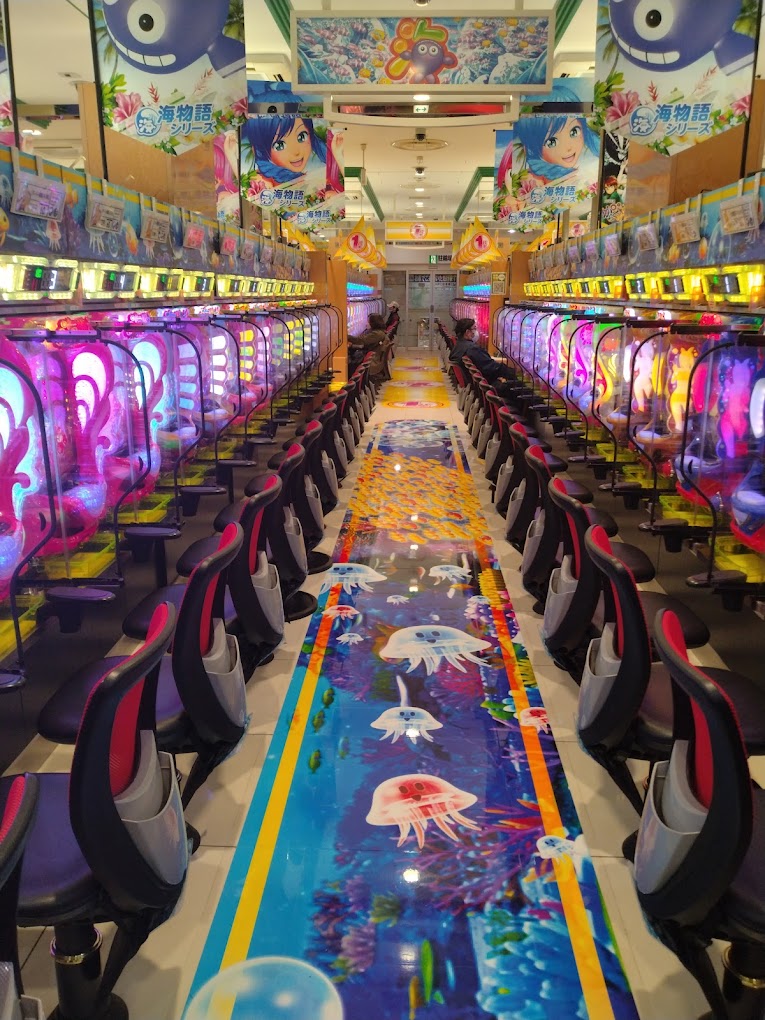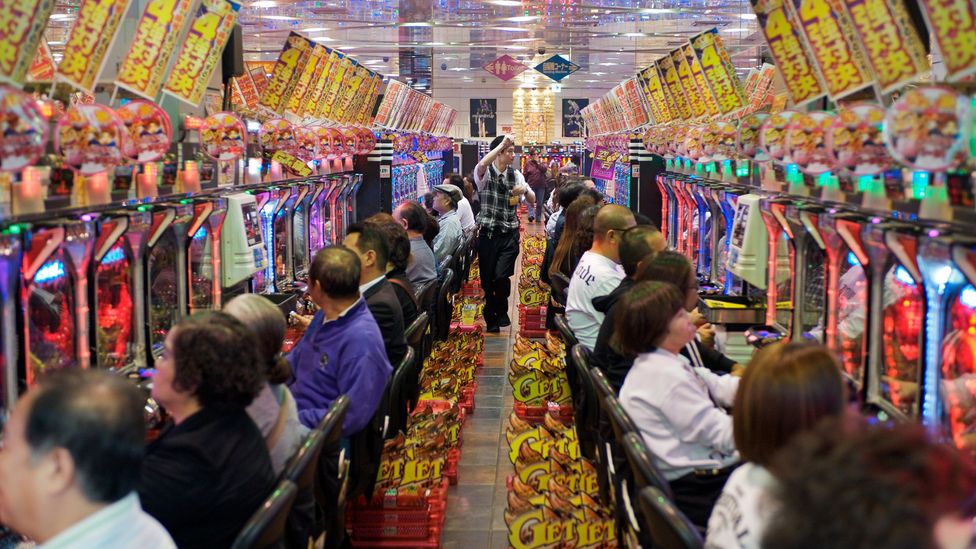Pachinko Parlors are vibrant, cacophonous gaming establishments that you’ll find scattered across cities and towns in Japan. Imagine walking into a room filled with the clang of metal balls, flashing lights, and the buzz of people engrossed in play. That’s the sensory experience a Pachinko Parlor offers. Unlike Western-style casinos, these parlors offer the game of Pachinko, a mechanical arcade game that’s a blend between a slot machine and a pinball machine.
The History of Pachinko Parlors
Tracing the lineage of Pachinko parlors takes us back to the 1920s, but the roots can be traced even further to the “Corinth game” from the United States. What started as a modest form of entertainment has evolved into a multi-billion-dollar industry. From the humble wooden machines of yesteryears to the cutting-edge digital terminals of today, Pachinko parlors have kept pace with technology, continually drawing a dedicated following.
How Pachinko Parlors Work
Understanding a Pachinko parlor begins with understanding the game itself. Players purchase a large number of small metal balls that are loaded into the Pachinko machine. They then manipulate a lever to launch these balls onto a vertical board filled with pins, pockets, and gates. The objective is to capture as many balls as possible, which can be exchanged for prizes or tokens at the end of the game. It’s a game of skill, luck, and timing, and the thrill comes from the randomness and unpredictability inherent to the mechanism.
The Legality of Pachinko Parlors in Japan
Legally speaking, gambling for cash is prohibited in Japan under the Penal Code. However, Pachinko parlors operate in a legal gray area by offering prizes or tokens, which can then be exchanged for cash at a separate location, usually a modest establishment located conveniently nearby but not within the parlor itself. This indirect exchange system circumvents the law, allowing the Pachinko industry to thrive.
The Cultural Significance of Pachinko Parlors in Japan
Beyond the flashing lights and noisy machines, Pachinko parlors hold a deep cultural significance in Japan. They serve as a microcosm of several aspects of Japanese society — from the dedication to craft seen in the intricately designed Pachinko machines, to the concept of “ikigai,” or a sense of purpose, that many older Japanese find in the game. Pachinko parlors are more than just places for leisure; they are woven into the cultural fabric, symbolizing both tradition and modernity in a rapidly changing world.
This concludes the first part of your article on Pachinko Parlors. By laying a strong foundation through these sections, you can capture the reader’s interest and provide a nuanced understanding of the topic before diving into more specific areas in subsequent sections.
The Sights and Sounds of Pachinko Parlors
Stepping into a Pachinko parlor is like entering a different world. The atmosphere is electric — literally and metaphorically — with neon lights casting a kaleidoscopic glow on rows of shiny machines. The acoustic landscape is just as rich, a cacophony of jingles, bells, and announcements that blend into a uniquely hypnotic soundscape. But it’s not just about sensory overload; many regulars find the atmosphere soothing, a kind of “organized chaos” that offers an escape from the mundanities of daily life.
How to Play Pachinko
Playing Pachinko isn’t complex, but it does require a basic understanding of the game’s mechanics. Here’s a quick guide:
- Purchase Balls: You start by purchasing a set number of small metal balls.
- Load and Launch: Load the balls into the machine and use a dial or lever to shoot them onto the playfield.
- Navigate: The balls navigate a maze of pins, gates, and pockets.
- Collect Rewards: Landing balls in certain pockets will trigger rewards, often leading to a cascade of additional balls.
Remember, the aim is to collect as many balls as possible, which can later be exchanged for prizes.
Tips for Playing Pachinko
- Study the Machine: Different machines have different layouts, so take a moment to study the playfield.
- Adjust Your Aim: The launching mechanism usually has settings that affect the angle and speed of your shots.
- Manage Your Resources: Don’t spend all your balls quickly; pace yourself for a more strategic play.
- Observe Others: If you’re new, it can be beneficial to watch experienced players to pick up on their strategies.
The Different Types of Pachinko Machines
Pachinko machines come in various forms, each with its own set of rules and rewards:
- Vintage Machines: These are old-school mechanical devices with basic features.
- Digital Machines: Modern versions equipped with video screens and interactive elements.
- Hybrid Machines: A blend of the traditional and the modern, often featuring elements of both.
- Themed Machines: These machines are built around specific themes, often tied to popular culture or historical events.
The Sights and Sounds of Pachinko Parlors
Stepping into a Pachinko parlor is like entering a different world. The atmosphere is electric — literally and metaphorically — with neon lights casting a kaleidoscopic glow on rows of shiny machines. The acoustic landscape is just as rich, a cacophony of jingles, bells, and announcements that blend into a uniquely hypnotic soundscape. But it’s not just about sensory overload; many regulars find the atmosphere soothing, a kind of “organized chaos” that offers an escape from the mundanities of daily life.
How to Play Pachinko in Pachinko Parlors
Playing Pachinko isn’t complex, but it does require a basic understanding of the game’s mechanics. Here’s a quick guide:
- Purchase Balls: You start by purchasing a set number of small metal balls.
- Load and Launch: Load the balls into the machine and use a dial or lever to shoot them onto the playfield.
- Navigate: The balls navigate a maze of pins, gates, and pockets.
- Collect Rewards: Landing balls in certain pockets will trigger rewards, often leading to a cascade of additional balls.
Remember, the aim is to collect as many balls as possible, which can later be exchanged for prizes.
Tips for Playing Pachinko
- Study the Machine: Different machines have different layouts, so take a moment to study the playfield.
- Adjust Your Aim: The launching mechanism usually has settings that affect the angle and speed of your shots.
- Manage Your Resources: Don’t spend all your balls quickly; pace yourself for a more strategic play.
- Observe Others: If you’re new, it can be beneficial to watch experienced players to pick up on their strategies.
The Different Types of Pachinko Machines in Pachinko Parlors
Pachinko machines come in various forms, each with its own set of rules and rewards:
- Vintage Machines: These are old-school mechanical devices with basic features.
- Digital Machines: Modern versions equipped with video screens and interactive elements.
- Hybrid Machines: A blend of the traditional and the modern, often featuring elements of both.
- Themed Machines: These machines are built around specific themes, often tied to popular culture or historical events.
The Prizes You Can Win at Pachinko Parlors
The endgame in Pachinko is to accumulate enough balls to exchange for prizes. These rewards can range from small trinkets and snacks to high-end electronics and luxury goods. In some cases, players can opt for special tokens or cards, which, while not redeemable for cash within the parlor, can be exchanged for money at a separate venue, as mentioned in the earlier section on legality.
The Economics of Pachinko Parlors
Pachinko is not merely a game; it’s a multi-billion-dollar industry. The economics are structured around the sale of metal balls and the subsequent redemption process. Players purchase these balls at the beginning and redeem them for prizes at the end. This model creates a consistent cash flow for the parlors. Additionally, the parlors also generate revenue through partnerships with prize manufacturers, food and beverage sales, and in some cases, licensing deals for themed machines.
The Biggest Pachinko Parlors in Japan
When it comes to scale, some Pachinko parlors are veritable entertainment complexes. Brands like Maruhan and Dynam are giants in the industry, with multiple locations that not only feature rows upon rows of Pachinko machines but also offer other forms of entertainment like bowling alleys and dining options. These mega-parlors serve as a testament to the immense popularity and profitability of the game.
1. The Best Pachinko Parlors in Tokyo
Tokyo, the bustling capital of Japan, is home to some of the finest Pachinko parlors. Among these, establishments like Maruhan Shinjuku and Adores Ikebukuro stand out for their prime locations, expansive game selections, and top-notch facilities. These parlors offer a mix of traditional and digital machines, attracting both seasoned players and curious newcomers alike.
2. The Most Unique Pachinko Parlors in Japan
While most parlors offer a standard experience, some go the extra mile to stand out. For example, KanColle Pachinko in Akihabara offers a maritime-themed experience complete with ship models and sea sounds. Another example is Anata No Warehouse in Kawasaki, designed to mimic the dystopian streets of Kowloon Walled City. These unique venues provide a Pachinko experience that’s unlike any other, catering to niche interests and adventurous players.
3. Pachinko Parlors in Osaka, Kyoto, and Other Cities
While Tokyo may be the epicenter of the Pachinko world, other Japanese cities offer their own distinctive flavors. In Osaka, Namba’s Dynam Pachinko is renowned for its lively atmosphere and wide range of machines. Kyoto, known for its rich history and culture, also hosts parlors like Big Apple Kyoto that offer a unique blend of tradition and modernity.
4. The Pachinko Parlors with the Biggest Jackpots
For those interested in the thrill of a big win, certain parlors specialize in machines with larger-than-average jackpots. Among these, Shinjuku’s Maruhan is a well-known hotspot, frequently offering jackpots that can exceed hundreds of thousands of yen. These parlors attract serious players looking for high stakes and high rewards.

5. The Pachinko Parlors with the Best Food and Drink
For many players, a Pachinko outing is incomplete without indulging in some culinary treats. Parlors like Adores Ikebukuro and Maruhan Shinjuku offer a range of food and drink options, from classic Japanese snacks to international cuisines. Some parlors even go as far as having in-house cafes and bars, elevating the overall experience to more than just gaming.

The Impact of Pachinko Parlors on Japanese Society
The influence of Pachinko parlors extends beyond the economic sphere into social and cultural realms. They serve as social hubs where people from various walks of life come together, be it young adults seeking thrills or older citizens looking for leisurely engagement. However, the industry is not without its criticisms, including concerns about problem gambling and its alleged ties to organized crime. These societal factors form an intricate part of the larger tapestry that is the Pachinko industry.
The Future of Pachinko Parlors in Japan
As Japan grapples with economic fluctuations and a changing demographic landscape, the future of Pachinko parlors is an intriguing subject. While they are facing challenges from an aging population and the rise of digital gaming platforms, innovations like immersive 3D Pachinko and tie-ins with popular media franchises indicate that the industry is seeking ways to adapt and evolve.
The Rise of Online Pachinko
The digital transformation has not bypassed Pachinko. Online platforms are emerging as a viable alternative, providing a similar gaming experience in the comfort of one’s home. These platforms often offer various game types, prize redemption options, and even live-streamed Pachinko games. While they haven’t yet replicated the sensory overload of a physical parlor, they are gaining traction, especially among younger audiences.

